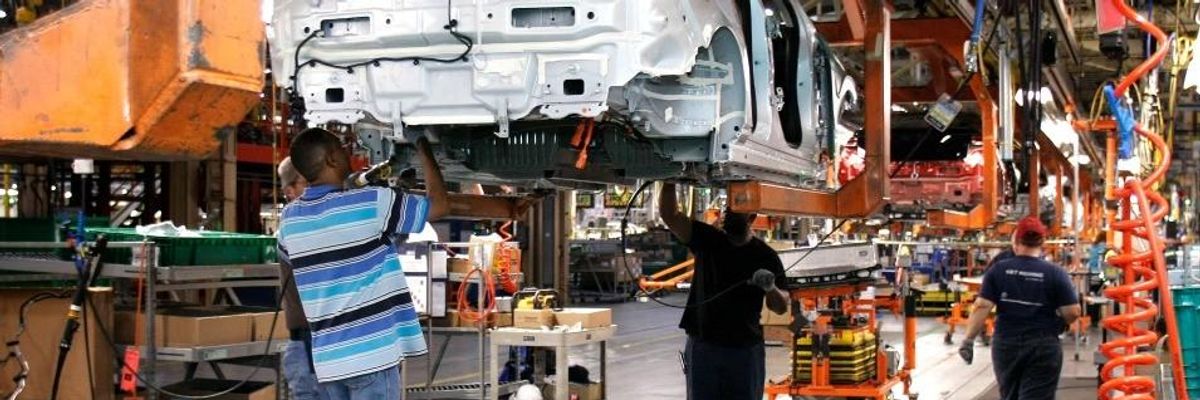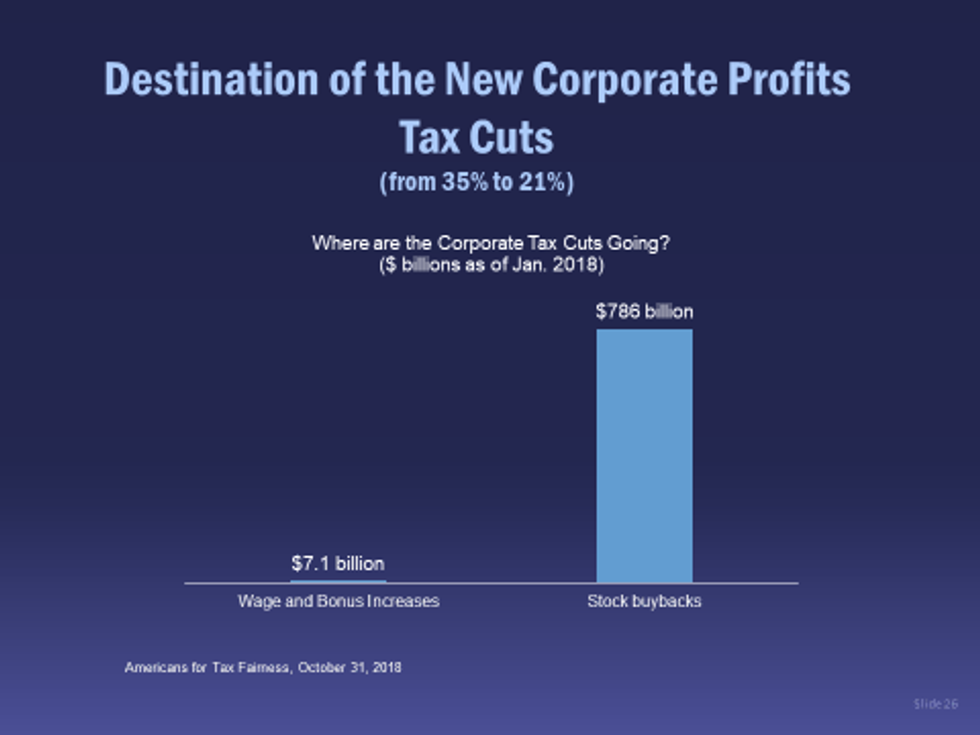President Trump has GM egg on his face.
He repeatedly promised that the car industry would create more and more jobs in the U.S., thanks to his "magic wand" of aggressive tax and tariff policies. But by announcing the elimination of 14,000 U.S jobs, GM revealed that conjurer tricks are no match for voracious capitalists.
Trump, of course, can never appear to back down. Instead, he is threatening to cut all subsidies to GM like tax credits for electric cars, which are vital to their development and sales. But, it's doubtful he has the power to match his bluster.
The Democrats seem perfectly content to let Trump rage against GM, knowing that his threats are unlikely to significantly change GM's reaction to "market forces." Meanwhile, the Democrats seem perfectly content to let Trump rage against GM, knowing that his threats are unlikely to significantly change GM's reaction to "market forces." GM wants to get out of small gasoline sedans as consumer tastes shift (due to low gas prices) to more profitable pick-up trucks and SUVs. Also, GM claims it will expand investments in electric and driverless cars.
To fan the flames, the Democrats are highlighting how Trump guaranteed more auto jobs in the Rust Belt. They repeat his recent rally boasts about how these jobs already are coming back, how car plants are expanding, and how he has done more than any other president to bring jobs back to the U.S. It's best, the Dems believe, to let Trump trip over himself.
But what exactly is the Democratic alternative?
Here's the tricky part. The current Democratic response goes something like this: Instead of theatrical tweeting, TV watching and golf outings, Democrats would do the hard work of engaging in serious discussions with GM to avert this kind of job disaster. They would find ways to construct incentive packages to help GM put new products into idled facilities. They also would remove the extra costs GM faces caused by Trump's foolish tariff wars.
The deeper problem for the Democrats is that too many are unwilling to break with Wall Street's financial model that took hold with the Reagan and Clinton administrations.
Good luck. Job retention victories are rare. Incentive packages usually fail over time because they do not alter rapacious corporate practices. But the deeper problem for the Democrats is that too many are unwilling to break with Wall Street's financial model that took hold with the Reagan and Clinton administrations. That model has to be dramatically altered in order to create and retain good jobs for working people.
Wall Street's Model to Financially Strip-mine America
GM along with most of Corporate America has bought into Wall Street's financial strip mining model. The goal, plain and simple, is to extract as much money as possible from the corporation and put it into the pockets of top corporate officers and big Wall Street investors.
The method of choice is stock buybacks--using the company's cash to buy back its own shares which usually puts upward pressure on the price of the shares. In yesteryear, this was called by its rightful name--stock manipulation. You are not supposed to manipulate the market price of your shares. That manipulation was believed to be a major cause of the 1929 stock market crash and it was basically outlawed until 1982, when the Reagan administration unleashed the process again.
Before 1980 about 95% of a CEOs pay consisted of salary and bonuses and about 5% were stock related grants. Today nearly 90 percent CEOs compensation consists of stock options and grants.
Since then, there's been a vast change in how CEOs get paid. Before 1980 about 95% of a CEOs pay consisted of salary and bonuses and about 5% were stock related grants. Today nearly 90 percent CEOs compensation consists of stock options and grants. This provides enormous incentives for all CEOs to use as much of the company's profits as possible to buy back its own shares. Now, more than 60% of all corporate profits go to stock buybacks, not R&D, not increasing worker wages, not better environmental controls. (For the definitive account of this process see William Lazonick, "Profits Without Prosperity.")
Obviously the big Wall Street hedge funds and private equity investors love this process. In fact, they take large stock positions in corporation and then clamor for more and more buybacks.
The recent Republican tax cut is a poster child for stock buybacks.
It was argued that cutting the corporate tax rate from 35% to 21% would make American firms more competitive and profitable, leading to more investments and increases in worker incomes. Here's what has happened to date--nearly all the money is going into stock buybacks.
GM's Business Model: More and more Stock Buybacks
As GM got on its feet again, it poured a good chuck of its cash reserves into stock buybacks. As CBS News reports:
The company has spent $10.6 billion since 2015 buying back its own shares, according to filings with the Securities and Exchange Commission. Stock buybacks do nothing for a company's productive capacity. But because buybacks reduce the number of shares on the market and thus make a stock more valuable, they can be popular with many investors as well as senior executives who are paid largely in stock.
This $10.6 billion in stock buybacks is more than twice the $4.6 billion GM hopes to save by killing 14,000 jobs.
Why didn't the Obama Administration Eliminate GM Stock Buybacks?
With GM nearing collapse in 2008, the Democrats had a golden opportunity to drastically reduce financial strip-mining. They just needed to go back to the 1982 Securities and Exchange rule, which then held that no more than 2% of a corporations profits could go to stock buybacks. If the Democrats were too jittery to do that for the entire economy, they at least could have demanded the elimination of stock buybacks at GM in exchange for the $50 billion taxpayer bailout. GM was in no position to resist.
But to do so would mean attacking Wall Street's flock of golden geese and that was, something the Wall Street wing of the Democratic Party refused to even consider. Stock buybacks are big money. It's the best tool Wall Street has for extracting wealth from corporations. It's the best way for corporate executives to get filthy rich. It's one of the main reason the CEO/worker wage gap has grown from $40 to 1 in 1970 to about $800 to 1 today. (Please see Runaway Inequality: An Activist's Guide to Economic Justice)
Until the Democrats are willing to stop the financial strip-mining, their plans for GM are suspect. In fact, they could lose the public relations battle to Trump who at least is using the bully pulpit to pound GM into keeping those plants open. We have yet to hear the Democratic Party attack GM's business model.
What would a visionary GM jobs plan look like?
Rather than allowing Trump and GM to set the terms of the debate, the progressive wing of the Democratic Party needs to break out of their neoliberal box. Not only should they call for the outlawing of stock manipulative buybacks, they should also demand a change in GM governance. They should look to the German co-determination model and demand that the GM board consist of equal numbers of business, labor, and community members.
It will take courage for the Democrats to break with the Wall Street model and to risk being labeled "socialistic." But, if ever there was a corporation that owes its entire existence to corporate socialism, it's GM.
With that kind of governance, GM would be forced to use its cash to serve the interests of all the stakeholders, not just the CEOs and Wall Street investors. It is doubtful that any stock buybacks would be permitted.
Could such a board react to changing consumer market preferences? Of course it could. If it was determined that the company needed to make product changes and idle certain factories, it could develop plans for new products for those plants. If that was not feasible, it could develop robust "Just Transition" plans to protect workers and communities. Such plans could provide full wages and benefits plus educational opportunities to all idled workers. The tab for those wages and benefits for 14,000 laid off workers would be about $1.5 billion for one full year, a fraction of GMs current stock buybacks. That would buy time for the company to find new products for these facilities.
If an overall reduction of jobs is deemed necessary one could imagine other Just Transition plans like providing early retirement to older workers at full pay to make room for younger workers. Those massive stock buyback funds provide the needed resources.
It will take courage for the Democrats to break with the Wall Street model and to risk being labeled "socialistic." But, if ever there was a corporation that owes its entire existence to corporate socialism, it's GM.
The Danger of Democratic Ducking
It's very tempting for the Democrats to propose nothing but platitudes as Trump flails away. But it would be a grave political mistake to leave the field to Trump. Yes, most of his ideas and plans are smoke and mirrors. But while he roars against GM, the Democrats seem oh so tame. If this continues, it is possible that working people in the mid-West will believe that Trump really is fighting for them.
"While [Trump] roars against GM, the Democrats seem oh so tame. If this continues, it is possible that working people in the mid-West will believe that Trump really is fighting for them."
Of course, there are more than a few Democrats who believe that it's a waste of time to worry about the so-called "white working class" -- or talk class divisions at all. Instead, the party should understand it already has an anti-Trump winning formula--women, minorities, the LGBTQ communities and college educated suburbanites. Why get involved into fights against corporate giants and liberal Wall Street allies?
Because these working people need the Democratic Party, and the Democrats need to realize there is no white working class. For example, among the 1.4 million workers in the motor vehicle work force, 26.7 percent are women, 75.7 percent are white, 13.7 percent are black, 6.2% are Asian, and 11.2 percent are Hispanic, according to the Bureau of Labor Statistics.
How can the Democratic Party be the party of justice without defending these workers too?


